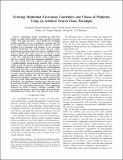| dc.contributor.author | Thangavelautham, Jekanthan | |
| dc.contributor.author | El Samid, Nader Abu | |
| dc.contributor.author | Grouchy, Paul | |
| dc.contributor.author | Earon, Ernest | |
| dc.contributor.author | Fu, Terence | |
| dc.contributor.author | Nagrani, Nagina | |
| dc.contributor.author | D'Eleuterio, Gabriele M. T. | |
| dc.date.accessioned | 2011-04-20T13:52:54Z | |
| dc.date.available | 2011-04-20T13:52:54Z | |
| dc.date.issued | 2010-03 | |
| dc.date.submitted | 2009-12 | |
| dc.identifier.isbn | 978-1-4244-4808-1 | |
| dc.identifier.uri | http://hdl.handle.net/1721.1/62246 | |
| dc.description.abstract | Autonomous robotic excavation has often been limited to a single robotic platform using a specified excavation vehicle. This paper presents a novel method for developing scalable controllers for use in multirobot scenarios and that do not require human defined operations scripts nor extensive modeling of the kinematics and dynamics of the excavation vehicles. Furthermore, the control system does not require specifying an excavation vehicle type such as a bulldozer, front-loader or bucket-wheel and it can evolve to select for an appropriate choice of excavation vehicles to successfully complete a task. The à ¿artificial neural tissueà ¿ (ANT) architecture is used as a control system for autonomous multirobot excavation and clearing tasks. This control architecture combines a variable-topology neural-network structure with a coarse-coding strategy that permits specialized areas to develop in the tissue. Training is done in a low-fidelity grid world simulation environment and where a single global fitness function and a set of allowable basis behaviors need be specified. This approach is found to provide improved training performance over fixed-topology neural networks and can be easily ported onto different robot platforms. Aspects of the controller functionality have been tested using high fidelity dynamics simulation and in hardware. An evolutionary training process discovers novel decentralized methods of cooperation employing aggregation behaviors (via synchronized movements). These aggregation behaviors are found to improve controller scalability (with increasing robot density) and better handle robot interference (antagonism) that reduces the overall efficiency of the group. | en_US |
| dc.language.iso | en_US | |
| dc.publisher | Institute of Electrical and Electronics Engineers | en_US |
| dc.relation.isversionof | http://dx.doi.org/10.1109/CIRA.2009.5423196 | en_US |
| dc.rights | Article is made available in accordance with the publisher's policy and may be subject to US copyright law. Please refer to the publisher's site for terms of use. | en_US |
| dc.source | IEEE | en_US |
| dc.title | Evolving multirobot excavation controllers and choice of platforms using an artificial neural tissue paradigm | en_US |
| dc.type | Article | en_US |
| dc.identifier.citation | Thangavelautham, J. et al. “Evolving multirobot excavation controllers and choice of platforms using an artificial neural tissue paradigm.” Computational Intelligence in Robotics and Automation (CIRA), 2009 IEEE International Symposium on. 2009. 258-265. © Copyright 2009 IEEE | en_US |
| dc.contributor.department | Massachusetts Institute of Technology. Department of Mechanical Engineering | en_US |
| dc.contributor.approver | Thangavelautham, Jekanthan | |
| dc.contributor.mitauthor | Thangavelautham, Jekanthan | |
| dc.relation.journal | Proceedings of the IEEE International Symposium on Computational Intelligence in Robotics and Automation (CIRA), 2009 | en_US |
| dc.eprint.version | Final published version | en_US |
| dc.type.uri | http://purl.org/eprint/type/ConferencePaper | en_US |
| dspace.orderedauthors | Thangavelautham, Jekanthan; Samid, Nader Abu El; Grouchy, Paul; Earon, Ernest; Fu, Terence; Nagrani, Nagina; D'Eleuterio, Gabriele M. T. | en |
| mit.license | PUBLISHER_POLICY | en_US |
| mit.metadata.status | Complete | |
